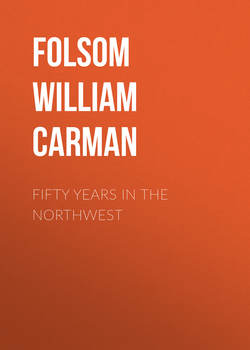Читать книгу Fifty Years In The Northwest - Folsom William Henry Carman - Страница 21
CHAPTER II.
STILLWATER AND ST. CROIX COUNTY
AMUSEMENTS. – SOCIETY BALL IN STILLWATER
ОглавлениеA writer in the Stillwater Lumberman, April 23, 1877, gives a sketchy account of an old time ball, from which we select a few items:
Anson Northrup kept what we called a first class hotel. If a man had blankets he could spread them upon the floor and sleep till the bell rang. If he had none he spread himself on the floor and paid for his lodging by tending stove and keeping the dogs from fighting. It was one of the aristocratic rules of the house that a man who slept in blankets was not to be disturbed by dogs.
At one time our popular landlord got up a ball. He sent round a copper colored card, – a half-breed Indian boy, – to tell all the folks to come. Everybody was invited. At the appointed hour they began to assemble. Soon all in town arrived except one Smith. Frequent inquiries were made for Smith, and at last a deputation was sent to inquire the cause of his absence; when it transpired that he had broken his leg. He said he was helping the landlord roll a barrel of whisky from the landing when the barrel slipped, and, rolling back on his leg, broke it. Northrup said that he had bet him one gallon of whisky that he could not lift the barrel to his lips and drink from the bung. In attempting to do this the barrel had slipped from his grasp with the result before mentioned. The wife regretted the accident very much, and said that if it had not been for that barrel of whisky, or some other whisky, they might have both attended the dance. She could have put out the fire, locked up the house, tied up the dog and taken her nine days' old baby with her. "There would be younger babies at the dance," she said.
Everything was ready. The ball opened with three "French fours," or two over. They danced a French two, the music consisting of one old violin with three strings, played by a half-breed from St. Croix Falls. He played but one tune and called it, "Off she goes to Miramachee." This carried a "French four" well enough, but when we danced a cotillion or hornpipe there was a great deal of rolling around instead of dancing. We often called for a new tune. "Oh, yes, gentlemen, you shall have him," but when we got him it was the same old "Off she goes." He worked hard to please the company and the sweat rolled down his manly cheeks like the droppings from the eaves of a saw mill; but all this would not do; it was the same old "Off she goes." There were twenty-four couples at the ball. The ladies brought with them their babies, fourteen in number, and ranging from six weeks to six months old. The night passed merrily, uproariously, but without tragic incident. The fiddler became at last so tipsy that he could no longer play "Off she goes to Miramachee," and staggered off to that locality himself. The only thing direful occurred at the breaking up, about five o'clock in the morning. The fourteen babies had been laid to sleep on a bed, but some malevolent genius during the dance mixed them up and changed their wraps, so that the mothers, in the hurry of their departure, gathered and took home with them each one some other mother's darling, and this deponent saith not that the snarl has ever been untangled and the babies restored to their rightful mothers.
With the year 1848 a new era dawned upon Stillwater and the valley of the St. Croix. Great changes had taken place in the little town. There were many new citizens, new buildings had been erected and the streets were much improved. Slabs had been placed over the quagmires on Main street. A stage route had been established to St. Paul, on which stages ran regularly. This was the first stage route in Minnesota.
The correction lines of the government survey had been run in 1846-7, chiefly in the latter year. Township, range and section lines were run in 1847, and in the early part of 1848. Prior to this claims had been made and were held subject to the limitations of the first legal survey. The creation of the new state of Wisconsin and the prospective organization of Minnesota Territory, the development of the lumbering business and the formal opening of the government lands to entry, gave an impetus to immigration. Stillwater profited largely by this immigration, it being an objective point. Population increased. The village was regularly surveyed and platted in the fall of 1848, Harvey Wilson, surveyor. Stillwater, although it never aspired to be the future capital of the Territory, became a headquarters for political characters and a place for public meetings for the discussions of territorial and other public questions. It was convenient of access, and contained up to that time a greater population than was to be found in St. Paul, and it seemed likely to become the commercial metropolis of the Territory.
